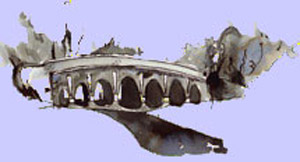| Colney Nature Watch Wild Life In London Colney |
| An article on the wild life in London Colney by Robin Cooper |
| A village in the country |
London Colney is surrounded by busy roads. Yet starting anywhere, and walking in any direction, you quickly find yourself in open countryside. The surrounding fields are full of wildlife which often enters the village.
Some will remember the day, several years ago, when everywhere you went there were blue butterflies. People sometimes see foxes raiding their dustbin bags. Others have found deer eating their fruit and flowers.
In cold winters, woodland birds migrate into the village, where it is slightly warmer, and people put out food. When farmers stopped keeping horses, they filled their ponds. Now garden ponds offer a fine habitat for newts, frogs and toads. Garden ponds, with their tame fish attract the unwanted attention of herons and gulls.
|
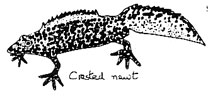 |
You can be too kind to wildlife. Blue tits normally eat grubs and insects. If you put out food scraps in spring, when they are feeding their babies, they'll give their babies the scraps you put out: this is not the babies' natural food, and you will kill them. If you visit Verulamium Lake, you will see what happens when birds are over protected, and there are no predator species. |
A steady stream of visitors bring food scraps. There is a large population of Canada geese at the lake.They rely totally on visitors' food. |
Sickly and malformed birds survive to breed, and today you see an unattractive flock of unhealthy, deformed birds. Remember, as you roam the countryside, it is illegal to pick wild flowers. Do not remove birds' eggs. If you want a permanent record of the flowers, birds and insects you see - buy a camera with micro and macro lenses. Our wildlife is to be cherished, we must ensure its survival for future generations. |
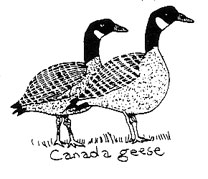 |
London Colney Nature Reserve |
This is bounded by the High Street, St Annes Road, Shenley Lane and the River Colne. There are free car parks by St Peter's Church and the British Legion hut. You can spend a morning in the Nature Reserve and afterwards dine at the Green Dragon or the Bull. Click here for a map of the reserve.
The reserve has three lakes which were gravel workings in the last century. Mining finished, the area reverted to nature. Later paths were cut through the wooded areas, and some were upgraded for people with pushchairs, or in wheelchairs.
There are several steep slopes, and in places the paths are unfenced. Small children should not enter the reserve without an adult. The lakes are deep in places, with undergrowth and abandoned mining equipment at the bottom. So it is dangerous to swim, and there are few places you can easily climb out. |
Long lake |
The southernmost of the three lakes, the Colne flows through this lake, leaving at the western end, where it passes under a footbridge and then under Shenley Lane. This is the lake where you are most likely to see the crested grebe. This magnificent bird, with its brown crest of feathers above its head, faced extinction in the nineteenth century because ladies wanted their feathers as fashion embellishments. |
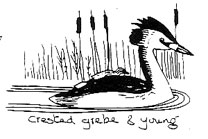 |
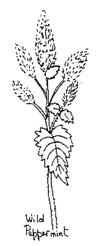 |
The RSPB was founded initially to protect grebes.There are paths all round Long Lake. The path along its southern edge is called Watery Lane. It is an RUPP - a Road Used as a Public Path. This means horses are legally allowed along Watery Lane. By the footbridge, which once spanned a motorway, is a colony of solitary wasps. Similar to ordinary wasps, they have long yellow legs. Nearby, on the north shore, is a hawthorn leafed crab apple tree. In autumn it yields small red apples which are simultaneously sweet and bitter.
The path along the northern edge approaches the lake in many places, where you can see wild peppermint and water forget-me-not growing. |
North lake |
North Lake has many varieties of water plants. You will see birds and insects that rarely visit our gardens. However, parts of the lake are inaccessible, with steep banks that are unfenced. Take care! In summertime, the western end is covered with water lilies |
You might be lucky enough to see coots and moorhens stepping from lily pad to lily pad. Even when no coots are visible, you will hear their quarrelling. Acrimonious birds; they will see off larger birds who stray into their patch. Coots are dark grey, with a white beak, and crest between the eyes. Moorhens are a bit smaller, with red beaks tipped with yellow. |
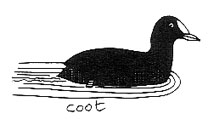 |
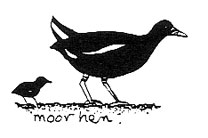 |
There are a couple of families of mallard resident at the lake, and you occasionally see Canada geese and swans there. Both species are at the uppermost limit in size for birds which can fly. Although they fly well, they need a long stretch of water from which to rake off. That is why they usually live on larger lakes. |
North Lake attracts migrants. There are times when you'll see large numbers of tufted duck on the lake. A beautiful bird, the male is black and white, with yellow eyes. In bright sunlight the head appears purple. The female is less spectacular - being various shades of brown. I once saw a gossander on the lake. A large duck with a thin, serrated beak - for holding the fish it loves to eat.Even in the coldest weather, do not skate on the lakes.
|
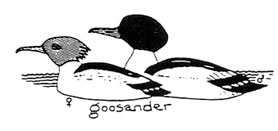 |
 |
The water is deep and it may be some time before anyone nor ices someone in the water. It would be difficult to get rescue equipment to the lake side,
On summer evenings, you’ll see some spectacular sunsets if you watch the setting sun over North Lake. |
| |
|
Small lake |
This lake lies between North Lake and Long Lake, All three lakes are connected by shallow channels, which are too shallow to allow fish migration, The only time migration occurs is during times of flood.
Small Lake is carefully managed to prevent overgrowth of reeds. If reeds are allowed unrestricted growth, they would quickly cover the lake area, and when they died, new plants would grow atop where they had been, and after a few years the lake would disappear. In cold weather, when the other two lakes freeze, Small Lake is often unfrozen, and you find that every water bird for miles around appears to have moved there. |
Between Long Lake and Small Lake is a bird hide, giving unobstructed viewing over Small Lake, In June you will get a superb view of the yellow flag irises growing there, Small Lake is difficult to reach. Although it is mainly shallow, there is a thick layer of silt on the bottom. If you wade into the lake, you will quickly sink, and find water flowing over the top of your wellies: so keep out! |
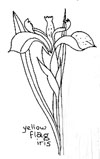 |
Fish and fishing |
Carp, tench and bream have been put in the lakes. Barnet Angling Club maintains the site, seeing no fishing detritus is left lying around, and felling trees to encourage spawning. The Nature Conservancy Council manages the site, felling old trees, and encouraging new growth. |
Sports fishermen replace their catch, and most fish die of old age, if they do not die earlier from fungal infections, or get eaten by pike, The commonest fish in the lakes are roach. They can be distinguished by their red fins, silver sides and greygreen backs. The lakes could probably benefit from more spawning areas, and there is the occasional danger to fish from industrial discharge, and the growth of toxic algae. |
 |
Dragonflies |
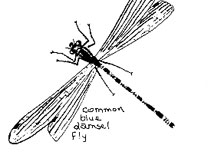 |
Most summers they are common. They hover and dart in pursuit of smaller insects. You are most likely to see the common blue damselfly, with its long, turquoise body, or the banded demoiselle, with its dark blue body, and transparent wings with black tips. Dragonflies do not bite people. They eat millions of insects, which would otherwise despoil our gardens. Although voracious hunters, they are not even able to defend themselves when caught in a spider's web. |
Wooded areas |
There's a wonderful variety of trees in the reserve: oak, ash, willow, birch, hawthorn, blackthorn and holly, There was once a small hawthorn leafed apple tree in the reserve, but I was unable to see it on a recent visit. Old trees are felled to create space for vigorous young growth, Felled trees are left on site, so insects can colonise the bark _ and hasten natural rotting, The insects attract birds.
Every year, students from the University of Hertfordshire study the ecology of the reserve, and already three students have been awarded Ph.D.'s for their research. |
Tree growth on the northern edge of North Lake is particularly verdant, with creepers growing on several trees. There are a couple a feral apple trees and also some crab apple trees. Their small, hard fruit are extremely sour, and I cannot imagine anyone eating them for pleasure!
Look out for blackthorn trees. A relative of the plum, their fruit is the sloe. Some years the fruit are abundant - other years there are none. Sloe gin was a speciality of the Victorian kitchen |
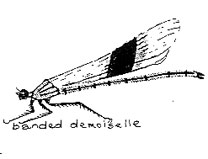 |
Summer time, round the woody margins you will see speckled wood butterflies. Large, and mainly cream and brown - at one time it was rare _ but it now appears to be making a comeback. They love living at woodland edges, and in large woods will congregate where trees have been felled and sunlight reaches the ground. |
 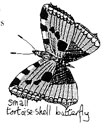 |
Between North Lake and Long Lake is a dense thicket of nettles. Nettles love growing where the soil is very fertile. For years, slaughter house refuse was dumped here. Several species of butterfly lay their eggs on nettles. That is why you see so many small tortoiseshell, and peacock butterflies. |
There are less than sixty species of butterfly in the UK. In this reserve I saw my first orange tip butterfly, and my first comma.
Many a person must have come home from the Nature Reserve, delighted at seeing something they'd never seen before, and then spent the next few days trying to discover its identity from nature books. |
 |
One morning I was there, and everywhere I looked, there were banded snails. All different colours - it was like examining a collection of jewels. There was the time I found a log covered with soldier beetles, and another time when I found a scarlet cardinal beetle. I've seen crested grebes doing their courtship ritual, and possibly my most spectacular find was a small moth, with pink and yellow wings. It is too small to have a common everyday name - and scientists call it "pyrausta sanguinalis".
However, you have to visit the Nature Reserve with the right frame of mind. If you go there expecting to find something unusual, you'll most likely be disappointed! |
Other places to see nature in the village |
Coppice Wood |
You pass this wood as you travel along Whitehorse Lane. For years it was unmanaged and louts dumped cars and furniture there. It is better now. In May, the woodland floor gleams with the millions of bluebells growing there. They thrive in gloomy places, where other plants cannot grow. It is a flower that seems to have no natural pests. Look out for aberrant bluebells - which are colours other than blue!There always seems to be white and red campion growing in this wood. At the furthest end is a fine thicket of raspberries - some of the nicest I've tasted. |
 |
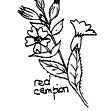 |
The eastern edge of Coppice Wood looks across the Upper CoIne Valley, towards Tyttenhanger House and Bowmansgreen Farm. Far away you can see the M25 going over Ridge Hill. If you've binoculars, it's worth examining the field below Coppice Wood, as herons and crows often congregate there. |
Lowbell lane |
The river by Lowbell Lane is rather lovely. The area has many British and exotic trees and lots of woodland birds. The grass is short, the land mainly level, and there are picnic sites. There is a free car park by St Peter's Church. The river is wide and slow moving. If you go towards the bridge carrying the bypass, you'll see lots of chubb in the river. There are a fair number of water birds here, but beware of the feral geese. They are aggressive and will attack anyone they think is carrying food they fancy |
No birds need feeding in summer, and there are times when the river edges here are quite unpleasant with the bread scraps lying around. It looks nasty, is not the birds' natural food, and attracts rats which can pass on Weil's Disease to people. |
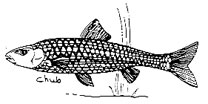 |
Terns sometimes visit this part of the river. They are small white birds with forked tails - sometimes called "sea swallows". They often fly along with their beaks pointing downwards as they scan the water, looking for fish. |
 |
When they see one, they plummet down, to emerge shortly after, with a fish in their beaks.
From here, the next kilometer or so has been artificially straightened. This induces unnatural scouring and means the water flows too fast. |
The Upper Colne Valley |
You follow the riverside path, under the bypass and you arrive at the Upper Colne Valley. To the left is the coppice "Big Mayfield Wood". The river gets narrower, until it is like a ditch. In places you can stand with a foot on each bank. The banks are heavily covered with vegetation. Look out for teazels, but take care - in some places the water is quite deep. Summer sees damselfly here, and also kingfishers. Hopefully, one day they will introduce new meanders into the river! |
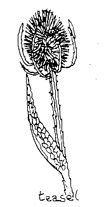 |
 |
Walking north ward from the bypass are the three lakes. Farm Lake, Bowmanslake sometimes called Match Lake and Deep Lake. These lakes fluctuate in size. A few summers back the southernmost lake dried up completely. |
It was interesting to see the many fresh water mussels that lived there. There is little vegetation near the lake edges. This means fish can see anglers long before they arrive, and lie low. |
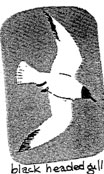 |
A large flock of Canada geese is often resident. Most times you will see mallards and crested grebes and also lots of gulls. I even saw a greenshank there once. There are usually a lot of gulls around. The commonest gull is the black headed gull. Once they were exclusively maritime birds. Over the years they have moved inland, and finding it to their liking, have stayed. They often live near rubbish dumps, where they forage for food. They often pursue ploughs, and eat the grubs as they are exposed. |
Napsbury Estate |
When the site was a hospital, a fine variety of exotic trees were planted, but most of them now are near the end of their natural lives. The trees attract insects, birds and squirrels. Look out for blue tits, great tits, coal tits, robins and thrushes. In the fields beyond you will see lapwings, redwings and high above the fields - skylarks. As the new housing estate is completed, and new people move in - we will see how the ecology of the site changes. |
Other wildlife |
Foxes are common, yet rarely seen. When your dustbin bags are ripped apart, and chicken bits removed, it is as likely to be foxes as the neighbour's cat. The only time I've seen foxes in the village has been at night time from my car. When you visit a zoo, go to the fox enclosure, and remember the smell. Quite unique, it stays around a long time; and some people can follow a fox's scent nearly as well as a bloodhound! |
Deer live in the surrounding woods. They hide by day, and come out around sunset to feed. One brave deer used the north end roundabout as its daytime hideout a few years back: a real deer of character!
Badgers once lived in Napsbury grounds. I've never seen one, but was shown a set: all the surrounding vegetation had black and white hairs on it.
St John's Wort is a yellow flower of some medicinal interest. It grows along the sides of Shenley Lane, and in the nature reserve. Hold a leaf to the sky, and you'll see small holes in the leaves, which in fact are globules containing oil.Daffodils grow profusely along roadsides, and at the village margins. The question is - are they wild flowers? The same question goes for grape hyacinth! |
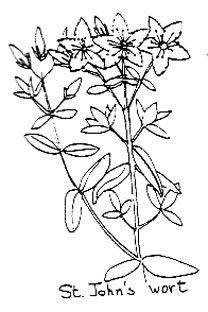 |
Dandelions are common from April onwards. The leaves make a nice salad. The roots can be powdered to make artificial coffee, and the flowers are still used for wine making. All pares of the dandelion are diuretic - hence its French name “pis-en-lit". |
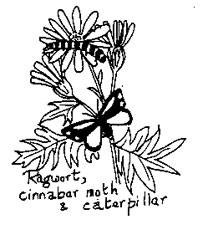 |
Ragwort is a similar colour, but poisonous to people, cows and horses. The smell is horrid, so don't pick it and then bring it indoors! When you find it growing in fields, examine it closely. In spring it may carry orange and black striped caterpillars that mature into cinnabar moths; a day flying moth with red and black wings.
A rare blue flower I found growing near Colney Heath is chicory. It is still used commercially as an additive to coffee. |
Places to see wildlife outside the village |
Here is a list of places where you can see wildlife. They are all free, and most have free car parks nearby. |
Stanborough Park - Welwyn-Hatfield |
This has two boating lakes - full of fish, a swimming pool, childrens' play areas and picnic areas. The grounds are gently landscaped: wild-flowers are encouraged. In June you can see yellow flag irises, and later hemp agrimony, a lavender coloured flower. |
 |
The lakes attract hosts of interesting water fowl, and there is a resident flock of Canada geese, with a barnacle goose living with them - it thinks it's a Canada goose! There are two car parks which are free except at weekends and in school holidays. |
Oakmere Park, Potters Bar |
Just off Potters Bar High Street, there is a free car park by the war memorial. The park is beautifully manicured, but despite this, the lakes attract many birds. I've seen a dozen mandarin ducks there on one occasion, also pochards and tree creepers. |
Stocker's lake |
 |
This is beyond Rickmansworth, and there is a free car park in Springwell Lane. Stocker's Lake is to the east of Springwell Lane, and Springwell Lake to the west. These two lakes are part of a chain of lakes, which were once gravel pits. They attract a large variety of water birds. I've seen goldeneye there. To get the best of these two lakes, bring binoculars and a picnic, and spend a day there. |
Verulamium lake, St Albans |
There is a pay car park at the St Michaels end. The lake attracts large numbers of water birds - too many, so that the grassy area round the lakes is unpleasant with goose excrement. Walk along the River Ver, and look out for the nests of coots, moorhens and mallards. A large number of birds, including grey herons nest on the island in the lake. Always look carefully at the birds on the lake, because you might well see a rarity. Grebe House in Verulamium Park has a nice wildlife garden which is open weekdays during office hours.
The large flock of Canada geese is a sad sight. Too many birds have been born deformed, and survived to breed. The large volumes of bird excrement has adversely affected the overall health of the water in the lake |
Lea Valley Park |
A string of abandoned gravel pits, which have been developed for recreational purposes, and to encourage wildlife. You will see an enormous variety of water birds and woodland birds here, as well as unusual wild flowers. There are several free car parks. At Waltham Abbey, by the car park is a visitors' centre, and a dragonfly reserve. At the Rye House car park is an RSPB reserve, which is free to members. The Lea Valley Park is an all day trip, so bring a picnic.
|
| |

